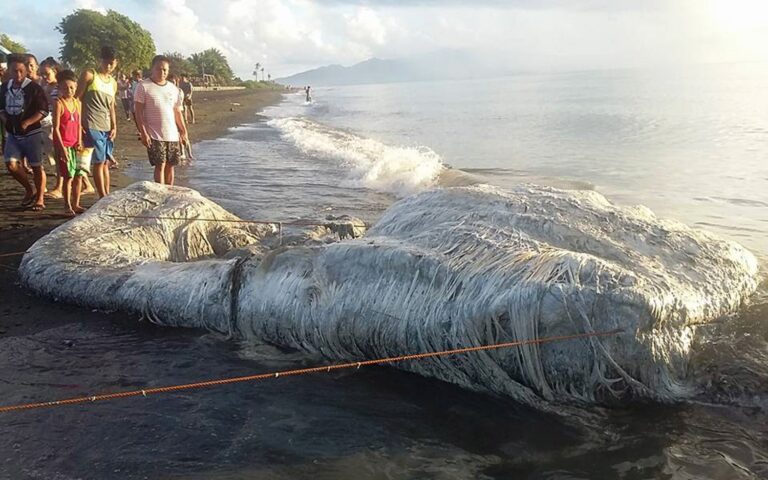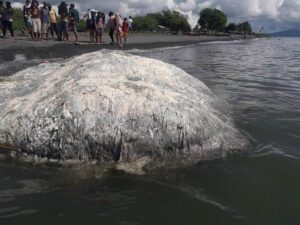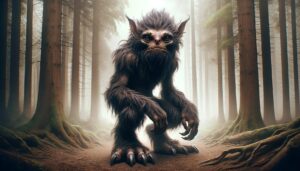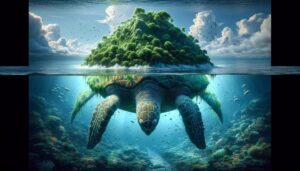Table of Contents
Globster, enigmatic mass, defy easy categorization. Found on beaches worldwide, these amorphous blobs baffle scientists. Their physical characteristics vary widely, presenting an array of textures, colors, and sizes. Despite extensive study, researchers often encounter challenges in classifying these mysterious entities.
One defining trait is their organic nature, resembling decomposed flesh. In some cases, bones or tendrils emerge, adding to the intrigue. The texture ranges from slimy to fibrous, complicating attempts to identify their origins. The color palette spans from pale whites to deep reds, contributing to the eerie ambiance surrounding these oceanic enigmas.
Transitioning to size, globster can be colossal, spanning several meters, or relatively small. Their physical composition raises questions about the creatures from which they may originate. The lack of clear features often leaves scientists grasping for clues, enhancing the mystique surrounding these perplexing entities.
Despite advancements in technology and scientific understanding, the physical description of globsters remains elusive. The enigma persists, inviting speculation and sparking curiosity about the depths of the ocean and the creatures that dwell within.
Scientific Analysis
The term “unidentified” in the context of globsters refers to the challenge of conclusively identifying the origin of these mysterious masses. While modern technology has significantly advanced our understanding of marine life, certain factors contribute to the difficulty in identifying globsters.
Decomposition: When these entities wash ashore, they are often in an advanced state of decomposition, making it challenging to recognize specific features or characteristics.
Lack of Clear Features: Globsters often lack distinctive features due to decomposition, and the texture, color, and shape can be altered, hindering accurate identification.
Limited Samples: In some cases, researchers may not have access to comprehensive samples of the globster. The nature of decomposition and the conditions of the discovery site can make it difficult to preserve these creatures for in-depth analysis.
Uncommon Species: Some globsters may be from deep-sea or rarely encountered species, making them unfamiliar to scientists and complicating identification.
Complex Marine Ecosystem: The vast and complex nature of the marine ecosystem means that undiscovered or rare species could contribute to the creation of globsters.
While technology has indeed improved, there are still challenges in identifying every specimen that washes ashore. Additionally, not all globsters are thoroughly studied or preserved for further investigation, contributing to the enduring mystery surrounding these oceanic enigmas.
Famous Globsters
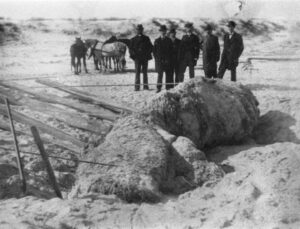
St. Augustine Monster
Discovered in 1896, the St. Augustine Monster became a renowned globster. Measuring over 20 feet, it baffled scientists. The creature’s massive size and peculiar appearance stirred public fascination.
Transitioning to scientific inquiry, initial attempts to identify the creature faced challenges due to its advanced decomposition. Despite the limitations of technology in the late 19th century, scientists collected samples for analysis. The lack of clear features hindered conclusive identification.
However, subsequent advancements in marine biology and DNA analysis shed light on the St. Augustine Monster. Modern research suggests it was likely a large mass of decomposed whale blubber and connective tissue. While the mystery of the St. Augustine Monster was eventually unraveled, its historical significance as a famous globster endures.
Tasmanian Globster
In 1960, the Tasmanian Globster washed ashore, perplexing onlookers with its massive, hairy mass. Scientists scrambled to study it. Despite technological limitations at the time, researchers collected samples for analysis.
The globster’s unidentified nature sparked public intrigue and media coverage. Subsequent scientific investigations offered varied theories, with some suggesting it could be decomposed flesh from a large marine creature. Yet, conclusive identification remained elusive.
Transitioning to the present day, the Tasmanian Globster remains a notable case in the history of globster discoveries. While the creature itself might have decayed, its legacy endures through discussions and continued fascination with mysterious oceanic phenomena.
Trunko
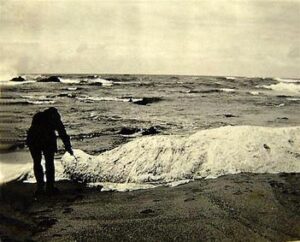
In 1924, the enigmatic Trunko washed ashore in South Africa, captivating witnesses with its peculiar features. Described as having a trunk-like appendage and a hairy, white body, Trunko quickly became a sensation. People reported that it engaged in a fierce battle with killer whales before reaching the shore.
Despite the lack of modern technology, locals and witnesses documented the creature extensively through photographs. The images fueled speculation about Trunko’s origin and nature. The creature’s unique characteristics, especially the reported trunk, added to its mystique and set it apart from other globsters.
The story of Trunko became intertwined with folklore and marine mysteries. However, scientific investigations into the creature’s identity were limited during that era. With technological advancements today, experts revisit historical cases like Trunko to reassess and analyze available evidence.
Trunko’s enduring legacy lies not only in its peculiar features but also in the way it captured the imagination of those who witnessed its unusual presence on the shores of South Africa. The mystery surrounding Trunko remains an intriguing chapter in the history of globster discoveries, showcasing how these enigmatic entities continue to fascinate and perplex us.
Bermuda Blob
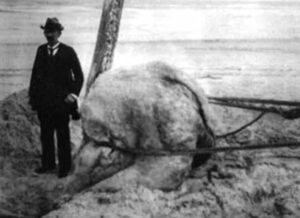
Discovered in 2016, the Bermuda Blob raised eyebrows with its mysterious appearance on the island’s shores. Locals and scientists alike were baffled by its gelatinous and translucent nature.
Scientists promptly collected samples, seeking to unravel the identity of this perplexing blob. While technological advancements allowed for in-depth analysis, the blob’s lack of distinct features complicated the identification process.
Despite extensive scrutiny, the Bermuda Blob’s origin remained elusive. Its discovery triggered public curiosity and media coverage. Although theories emerged, conclusive evidence regarding the nature of this globster remained inconclusive.
Transitioning to the broader context of globsters, the Bermuda Blob added a contemporary chapter to the ongoing saga of mysterious oceanic discoveries. The fascination surrounding these enigmatic entities endures, reminding us of the vast mysteries still concealed beneath the ocean’s surface.
Dinagat Island Globster
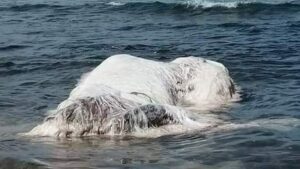
In 2017, the Dinagat Island Globster appeared as a colossal, hairy mass, puzzling witnesses and authorities alike. Its bizarre features stirred local intrigue. Documented extensively, the creature’s appearance included hair-like structures, creating an otherworldly spectacle on the shore.
Authorities, faced with the challenge of identification, collected tissue samples for DNA testing. Despite initial fascination, the decision to leave the globster on the shore raised concerns. The decomposition process, accelerated by exposure, presented challenges for scientific analysis.
DNA results, when obtained, added to the perplexity, offering no clear identification. Meanwhile, the globster’s presence continued to generate speculation and discussions within scientific and local communities.
Transitioning to the broader context of globsters, the Dinagat Island case exemplifies the complexities surrounding these mysterious oceanic discoveries. The decision to allow natural decomposition highlights the practical challenges in studying such phenomena, leaving us with more questions than answers.
Environmental Significance
Discovered globsters pose ecological questions. Decomposition impacts local ecosystems. The influx of such masses may influence marine life dynamics.
Moreover, studying globsters aids understanding marine biodiversity. The organisms associated with these masses provide insights into oceanic ecosystems and their health.
Transitioning to the ecological footprint, the impact of globster decomposition on local flora and fauna requires further exploration. Scientific analysis could reveal potential correlations between these mysterious entities and broader environmental patterns.
In conclusion, globsters persist as enigmatic oceanic phenomena. Historical and modern cases defy easy explanations. Despite technological advancements, conclusive identifications remain elusive.
Transitioning to reflections, the fascination with globsters endures. Their mysterious nature captivates imaginations, serving as reminders of the vast unknowns within our oceans. The enduring mystery invites ongoing scientific exploration and cultural intrigue.
FAQ
What is the myth of the globster?
The term "globster" is associated with real-life occurrences of mysterious masses, and there is no specific myth surrounding it. However, these discoveries often spark speculation and myths about sea monsters.
How big is the globster?
The size of a globster can vary widely, ranging from a few meters to much larger. The dimensions depend on the specific instance and the creature's original size.
What is a hairy globster?
A hairy globster is a type of unidentified mass found on beaches with a hairy or fibrous appearance. These entities often prompt curiosity due to their unusual characteristics.
What is the origin of the word globster?
The term "globster" is a blend of "glob" and "monster," reflecting the unknown and monstrous appearance of these organic masses.
What creature was washed up in the Philippines?
The Dinagat Island Globster is an example of a mysterious creature that washed ashore in the Philippines in 2017.
What creature was washed up on the shore 2023?
a Pacific football fish washed up on an Orange County beach on October 13, 2023. This unusual and rarely seen fish, known for its distinctive appearance, was found for the second time in three years. The discovery adds to the intriguing occurrences along the coastline, showcasing the diversity of marine life and the occasional appearance of unique species.
